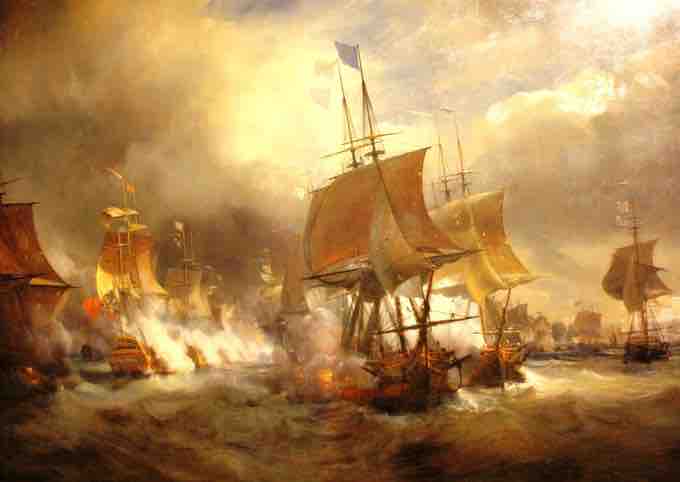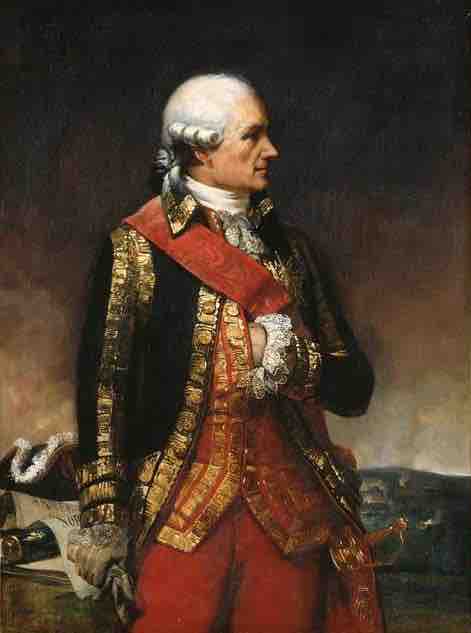Following the Declaration of Independence, the American Revolution was well received in France, perceived by many to be the incarnation of the Enlightenment spirit. Benjamin Franklin, dispatched to France in December 1776 to rally support, was warmly welcomed. But the French also had other reasons for supporting the Patriots. France bitterly resented their loss in the Seven Years’ War, in which they fought against Great Britain and lost a number of their territories in North America as well as favorable trading status in ports along the Indian subcontinent. The French were keen on ensuring that the British did not tip the balance of power further in their favor, and many in France perceived the American Revolution as an opportunity to strip Britain of their North American possessions in retaliations for French losses a decade previously.
Prior to France's official involvement, King Louis XVI and the French Foreign Minister Charles Gravier, the comte de Vergennes, authorized merchants to covertly sell gunpowder and ammunition to the Patriots. French ports also accommodated Continental Navy warships that acted against British merchant ships. France also provided significant economic aid and technical assistance in terms of military strategy. Individual French volunteers, moved by the prospect of glory in battle or animated by sincere ideals of liberty and republicanism, joined the American army. Examples of these volunteers include Pierre Charles L’Enfant and Gilbert du Motier, Marquis de Lafayette. Lafayette enlisted in 1777 at the age of 20 in defiance of King Louis XVI’s orders. He became an aide to General George Washington and a combat general. Most importantly, the charming young aristocrat helped to solidify a favorable American stance towards France and lended legitimacy to the war among potential European supporters.
In 1777, news of the Patriot victory at the Battle of Saratoga was received with great enthusiasm in France. Following this victory, King Louis XVI immediately negotiated an alliance with Benjamin Franklin. France formally recognized the United States on February 6, 1778, with the Treaty of Alliance. The treaty provided open support from the French army, navy, and Treasury. As a result, Britain declared war on France on March 17, 1778.
France was also instrumental in securing Spain’s involvement in the Revolutionary War. On April 12, 1779, France and Spain signed the Treaty of Aranjuez. Under the terms of the treaty, France agreed to aid in the capture of Gibraltar, the Floridas, and the island of Minorca in return for Spain’s agreement to join in France’s war against Great Britain. In June 1779, Spain launched the unsuccessful Great Siege of Gibraltar, the first and longest Spanish action in the Revolutionary War, which lasted until February 1783. In 1781, the Spanish defeated the British at the Battle of Pensacola, giving the Spanish control of West Florida. In 1782, Minorca surrendered to a combined Franco-Spanish force, restoring the territory to Spain nearly 80 years after it had initially been captured by the British.The French navy provided valuable assistance to the Patriots and engaged British naval forces several times in 1778 and 1779, in European and North American waters. Under François-Joseph Paul, Marquis de Grasse Tilly, comte de Grasse, the French defeated a British fleet at the Battle of the Chesapeake in 1781, ensuring the success of allied ground forces in the Siege of Yorktown, the last major land battle of the Revolutionary War.

1778 Battle of Ushant by Théodore Gudin, ca. 1848
The Battle of Ushant was the first naval engagement between Britain and France in the Revolutionary War.
In 1780, Jean-Baptiste Donatien de Vimeur, comte de Rochambeau, was appointed commander-in-chief of the French Expeditionary Force. He was given command of approximately 7,000 French troops and sent to join Washington's Continental Army. Rochambeau landed at Newport, Rhode Island, in July 1780, and remained there for a year to support the French fleet blockaded by the British in Narragansett Bay. In July 1781, Rochambeau's force left Rhode Island, marching across Connecticut to join Washington on the Hudson River at Dobbs Ferry, New York. In mid-August 1781, Washington and Rochambeau led the Celebrated March of combined Franco-American forces towards Virginia and the siege of Yorktown.

Rochambeau at Versailles
The comte de Rochambeau served as commander-in-chief of the French Expeditionary Force, which supported the Continental Army.

Second Battle of the Virginia Capes by V. Zveg
This painting depicts French (left) and British ships (right) at the battle of the Chesapeake.